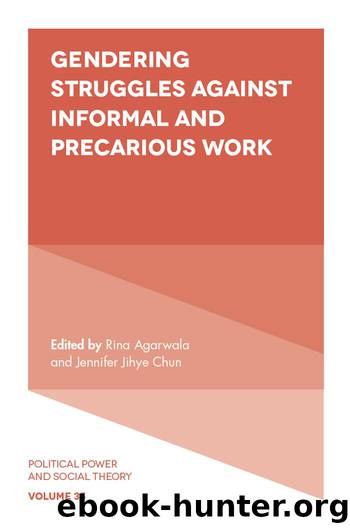Gendering Struggles Against Informal and Precarious Work by Agarwala Rina;Chun Jennifer Jihye;

Author:Agarwala, Rina;Chun, Jennifer Jihye;
Language: eng
Format: epub
Publisher: Emerald Publishing Limited
Published: 2018-11-20T00:00:00+00:00
CONSTRUCTING HEGEMONIC MASCULINITY
Within the context of the guest worker program, I argue that hegemonic masculinity is intersectional; however, its various components are framed under the umbrella of whiteness. While the formation of a hegemonic masculinity entails factors such as Christianity, distance from homosexuality, and proficiency in American English, these are each performed within the boundaries of whiteness. For instance, white American norms of heteronormativity are established as acceptable in contrast to Indian heteronormative masculine behaviors. Similarly, the English proficiency of male workers is contested due to their Indian accents and use of British vernacular. The combination of non-western religious practices, proficiency in languages from the Global South, and non-American behaviors of affection place Indian men as outside the purview of white masculinity. The work site practices construct a hegemonic masculinity primarily along the lines of race, which informs the intersection of Christianity, English language proficiency, and heteronormativity. It is this articulation of hegemonic masculinity that is used as a strategy of labor control within the guest worker program.
Hegemony is a continual practice of establishing dominance; the process of constructing hierarchies of masculinities is no different. In Connellâs words, âhegemony did not mean violence, although it could be supported by force, it meant ascendancy achieved through culture, institutions, and persuasionâ (Connell & Messerschmidt, 2005, p. 832). Within the labor camps, workers are subjected to a variety of punitive practices as well as more discursive forms of persuasion in the construction of a hegemonic masculinity. Employers establish hierarchies of manhood by erasing public performances of differing masculinities. However, the very process of creating a normative masculinity has the outcome of labor control. As shared earlier, these include restrictions on mobility, dangerous jobs at the work site, and instilling fear and subservience in workers. While there is a process by which masculinity of Indian men is made to be subordinate, in doing so, employers are able to obscure forms of labor exploitation as instead deviations from hegemonic masculinity.
Download
This site does not store any files on its server. We only index and link to content provided by other sites. Please contact the content providers to delete copyright contents if any and email us, we'll remove relevant links or contents immediately.
International Integration of the Brazilian Economy by Elias C. Grivoyannis(57387)
The Radium Girls by Kate Moore(10915)
Turbulence by E. J. Noyes(7057)
Nudge - Improving Decisions about Health, Wealth, and Happiness by Thaler Sunstein(6642)
The Black Swan by Nassim Nicholas Taleb(6203)
Pioneering Portfolio Management by David F. Swensen(5615)
Rich Dad Poor Dad by Robert T. Kiyosaki(5162)
Zero to One by Peter Thiel(4834)
Man-made Catastrophes and Risk Information Concealment by Dmitry Chernov & Didier Sornette(4748)
Secrecy World by Jake Bernstein(3788)
Millionaire: The Philanderer, Gambler, and Duelist Who Invented Modern Finance by Janet Gleeson(3575)
Skin in the Game by Nassim Nicholas Taleb(3477)
The Age of Surveillance Capitalism by Shoshana Zuboff(3431)
The Money Culture by Michael Lewis(3291)
Skin in the Game: Hidden Asymmetries in Daily Life by Nassim Nicholas Taleb(3271)
Bullshit Jobs by David Graeber(3190)
The Dhandho Investor by Mohnish Pabrai(3175)
The Wisdom of Finance by Mihir Desai(3086)
Blockchain Basics by Daniel Drescher(2895)
